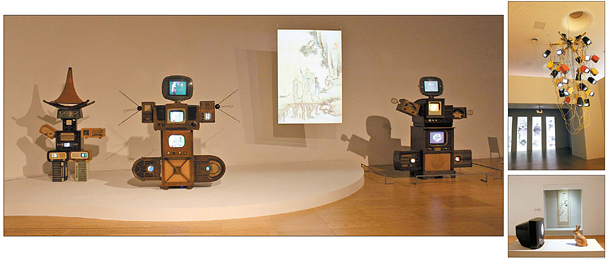The ties that bind Korean art pioneers : Kansong Art Museum and Nam June Paik Art Center collaborate in new exhibit

Counterclockwise from above, Nam June Paik’s video installation “Rabbit Inhabits the Moon” is presented alongside Jang Seungeop’s painting “Dog Barks at the Moon under the Empress Tree.” Paik’s installation “Video Chandelier No. 1” is on display with a digital image of Jang Seung-eop’s “Still Life.” Paik’s TV sculptures that respectively depict three historical figures of the East and West are installed together with a digital image of Choi Buk’s painting “Laughter of Three Men in Hogye.” The original painting is also displayed at the exhibition in another area. [MOON SO-YOUNG]
The “Alternative Dreams” show, which runs through Feb. 5, has been organized in collaboration between the Kansong Art and Culture Foundation and the Nam June Paik Art Center based on their joint research into their collections. The exhibition focuses on dreams of utopia as reflected in the works by Joseon-period (1392-1910) artists and Paik.
Among the exhibits is “Road to Shu Scroll,” an 8.2-meter-long (26.9-foot-long) ink painting that leads viewers on a journey throughout an idealized landscape of spectacular mountains and rivers. The work by Sim Sa-jeong (1707-69) is on display together with Paik’s video installation “Elephant Cart,” which depicts Buddha traveling on a cart being pulled by an elephant. The cart is covered in TV monitors showing images of elephants.
In another corner is Paik’s video installation “Rabbit Inhabits the Moon,” which consists of a TV monitor that shows the pale full moon and a wooden rabbit that stares at it. Over the installation hangs Jang Seung-eop’s (1843-97) ink and color painting “Dog Barks at the Moon under the Empress Tree.”
Paik famously said that the “Moon is the oldest TV.” In ancient East Asian mythology, the moon is a beautiful, ideal world where white jade rabbits make the elixir of life.
Jang’s dog, who represents the artist, barks at the moon, yearning for it, while Paik’s rabbit shows its hometown replaced by the image of the TV monitor.
The paintings by the four Joseon artists chosen for the exhibition respectively show their own Utopian visions based on Buddhist and Taoist ideas, according to Lee Jin-myung, curator of Kansong. They are Kim Myeong-guk (around 1600-63) and Choi Buk (1712-86) as well as Sim and Jang.
Paik, a cosmopolitan artist who was born in Korea and active in Japan, Germany and the United States, inherited the Buddhist and Taoist views of utopian ideas while developing his insights into new media and technology, as well as visions about the new world through exchanges with Western artists, engineers and scholars.
“He wished for the world to become connected as one, and for art and technology to form harmony,” Lee said. “He was an optimistic idealist who hoped for the advancement of human civilization through reconciliation between Eastern and Western civilizations.”
“The exhibition is also meaningful as Kansong [the pen name of Chun Hyeong-pil, an important collector and the founder of the museum] tried to protect Korea through art while Paik make efforts to show Korea to the world through art,” said Suh Jin-suk, director of the Nam June Paik Art Center.
To celebrate Chun, Bryan Ku, director at the virtual reality-focused EVR Studio, has created a VR film that leads the viewers on a journey into Kansong Museum and an imaginary world made up of elements of the art works in the museum’s collections.
MOON SO-YOUNG [symoon@joongang.co.kr]
Admission is 8,000 won ($6.80) for adults. The museum is closed on Monday. Go to Dongdaemun History and Culture Park Station, line Nos. 2, 4 and 5, exits 1 and 2.
For details, visit www.ddp.or.kr or www.kansong.org or http://njpac-en.ggcf.kr










with the Korea JoongAng Daily
To write comments, please log in to one of the accounts.
Standards Board Policy (0/250자)